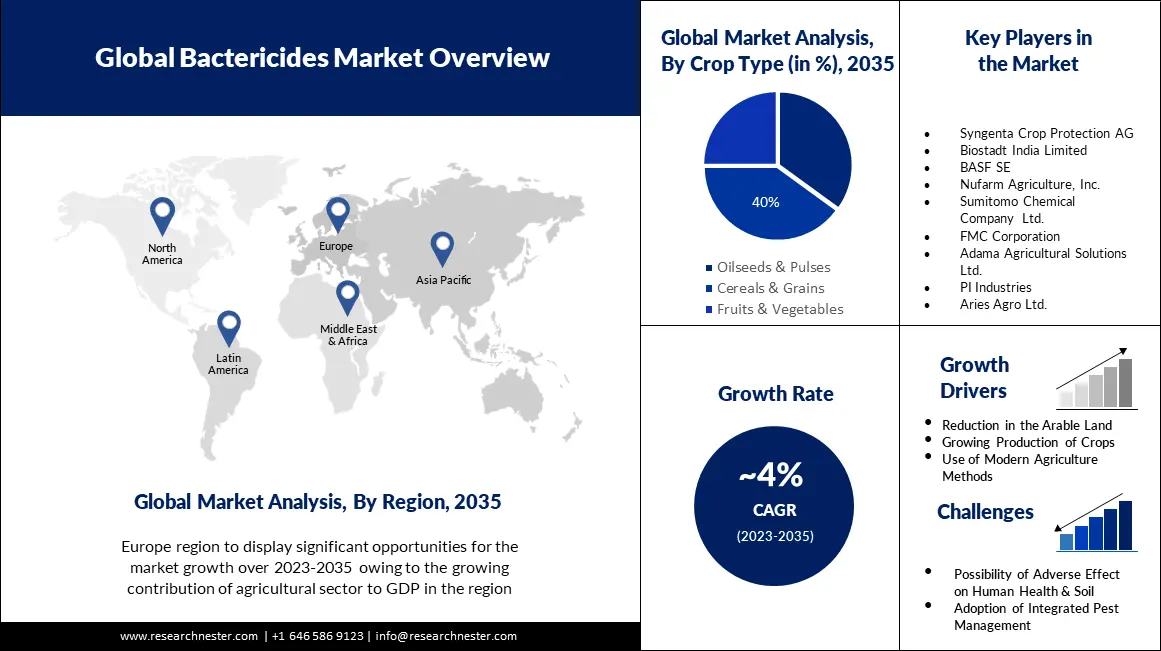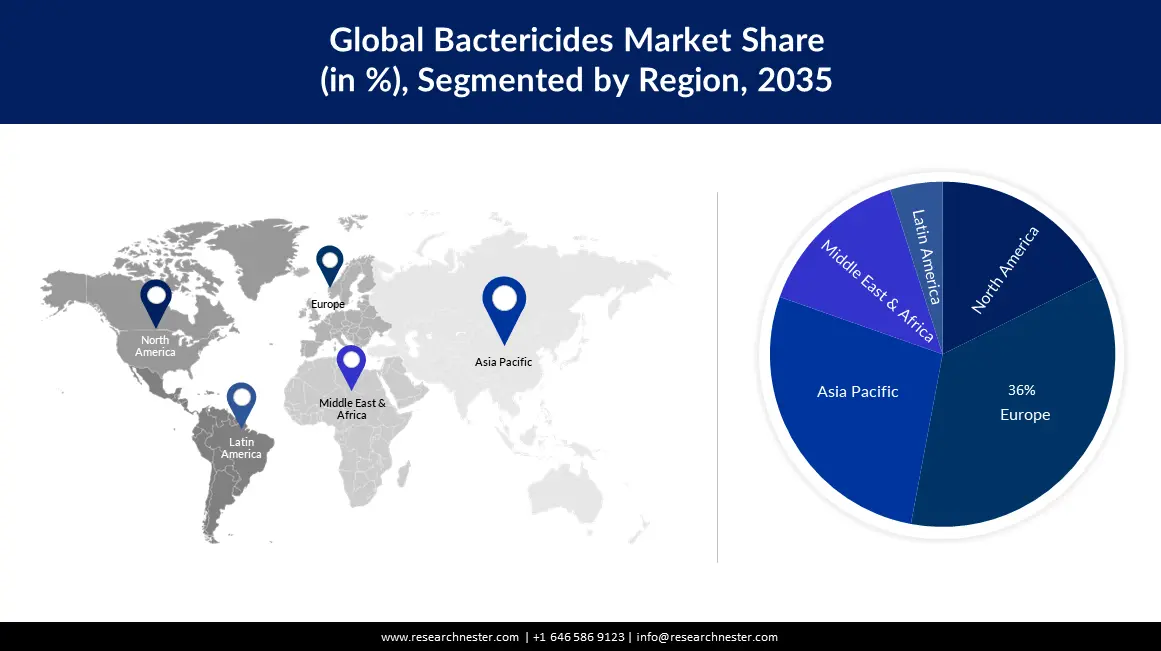
Bactericides Market size is poised to cross USD 13 Billion by the end of 2035, growing at a CAGR of over 4% during the forecast period, i.e., 2023 – 2035. In the year 2022, the industry size of bactericides was USD 9 Billion. The rising cases of crop ruin due to bacterial infestation highlight the need for effective measures to control and manage bacterial disease in agriculture. Bacterial infection can cause significant damage to crops, leading to yield losses, reduced quality, and economic hardships for farmers.
Besides this, the growing efforts by regulatory bodies to ensure food safety are significantly contributing to the bactericides market growth. For instance, Global Strategy for Food Safety 2022-2030 by the WHO aims to minimize the burden of foodborne infections by ensuring that all people consume safe, & healthy food, everywhere. Regulatory bodies often promote and enforce good agricultural practices, which include guidelines for bactericides use, application technique, and ensuring public health.

Growth Drivers
Challenges
|
Base Year |
2022 |
|
Forecast Year |
2023-2035 |
|
CAGR |
~4% |
|
Base Year Market Size (2022) |
~ USD 9 Billion |
|
Forecast Year Market Size (2035) |
~ USD 13 Billion |
|
Regional Scope |
|
Mode of Application (Soil Treatment, Foliar Spray)
The foliar spray segment is estimated to hold 60% share of the global bactericides market by 2035. Foliar spray is the most used technique for spreading bactericides. This is owing to its high efficiency and easy-to-use technique, farmers highly prefer it. By the use of foliar spray, the bactericides can be directly applied on the leaves or the whole plant which damages the quality of the soil. Therefore, it is beneficial for plants affected by nutritional deficiencies. On the other hand, it is easy to use and simple equipment, eliminating labor and machinery costs.
Crop Type (Oilseeds & Pulses, Cereals & Grains, Fruits & Vegetables)
The cereals & grains segment in the bactericides market is expected to be responsible for around 40% in the year 2035. The growth of the segment is primarily attributed to the growing production and use of cereals and grains. According to FAO's preliminary prediction, worldwide grain consumption in 2023/24 is expected to reach around 2,803 million tonnes, gaining 0.9 percent from 2022/23 levels. The global cereal output in 2023 and utilization in 2023/24, global grain inventories could climb by 1.7 percent above their original levels, hitting a record 873 million tonnes. Bactericides can be used in cereal and grains to control bacterial diseases that can negatively impact crop health and yield. The bacterial disease can infect various parts of cereal and grain crops, including the leaves, stems, heads, and kernels. Bactericides are used to suppress or manage bacterial pathogens, minimizing the damage caused by these diseases.
Our in-depth analysis of the global bactericides market includes the following segments:
|
Type |
|
|
Mode of Application |
|
|
Crop Type |
|
European Market Forecast
The bactericides market in Europe is expected to expand at a substantial CAGR and will cover the largest with a share of approximately 36% by the end of 2035. The higher contribution of the agriculture sector to European GDP is the main factor driving the market growth in the region. Agriculture accounted for 1.4% of the EU GDP in 2022. Agricultural revenue per yearly work unit is expected to climb by an additional 12.5% in the EU in 2022, reaching a level 44.3% higher than the index level in 2015. On the other hand, the rising use of bactericides and growing practices of modern agriculture techniques is also expected to augment the market growth in the Europe region.
APAC Market Statistics
The Asia Pacific bactericides market will be projected to be the second-biggest with a share of around 28% by the end of 2035. The growing production of crops in the region is one of the major factors that is anticipated to boost the bactericides market in the Asia Pacific region. According to the Second Advance Estimate for 2022-23, cumulative foodgrain production in India is expected to reach an all-time high of 3235.54 lakh tonnes, up 79.38 LMT from the previous year 2021-22. Moreover, there is growing awareness among farmers in the Asia-Pacific region about the importance of crop protection and the need to manage bacterial diseases effectively. This increased awareness and knowledge are contributing to the growing demand for bactericides in the region.



Author Credits: Shivam Bhutani, Anil Kumar
FREE Sample Copy includes market overview, growth trends, statistical charts & tables, forecast estimates, and much more.
Have questions before ordering this report?